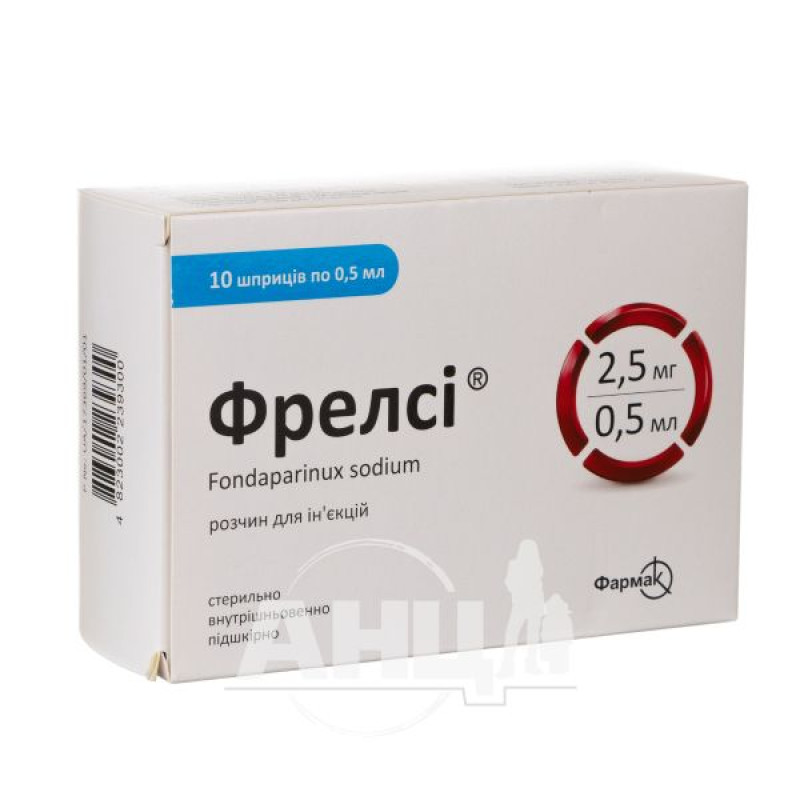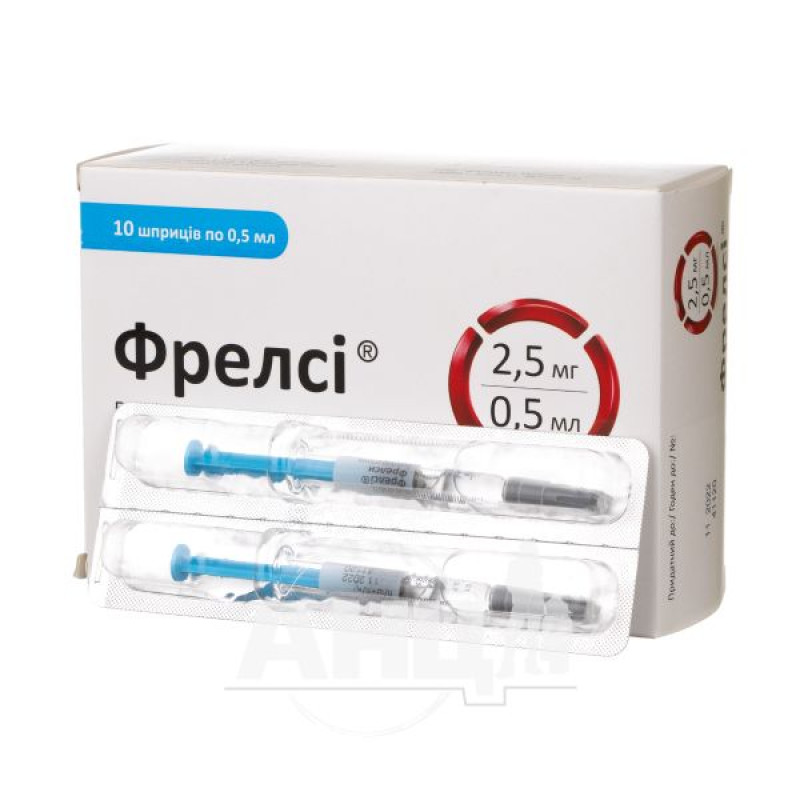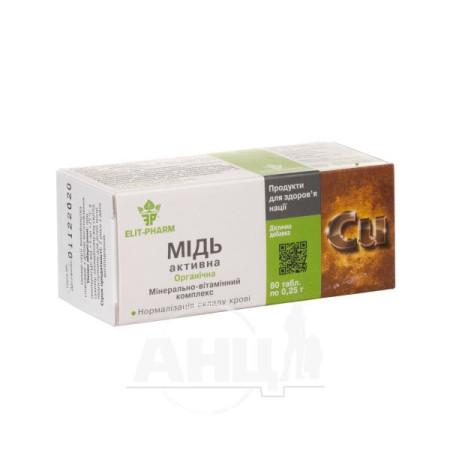Frelsy solution for injection 2.5 mg/0.5 ml syringe in blister 0.5 ml No. 10

Frelsy injection solution is used for the following indications:
prevention of venous thromboembolism in patients after major orthopedic surgery on the lower extremities, including hip fracture (including extended prophylaxis), and hip and knee joint replacement surgery; prevention of venous thromboembolism in patients after abdominal surgery who are at high risk of thromboembolic complications, for example in patients after abdominal surgery due to cancer; prevention of venous thromboembolism in patients with a high risk of such complications due to prolonged limitation of mobility during the acute phase of the disease, such as heart failure and/or acute respiratory disorders, and/or acute infectious or inflammatory diseases; treatment of unstable angina or non-ST segment elevation myocardial infarction in patients for whom urgent (<120 minutes) invasive intervention (percutaneous coronary intervention - PCI) is not indicated; treatment of ST-segment elevation myocardial infarction in patients treated with thrombolytics or in those who have not initially received other forms of reperfusion therapy.Composition
The active substance is fondaparinux sodium (1 syringe (0.5 ml) contains fondaparinux sodium - 2.5 mg).
Excipients: sodium chloride, 1 M hydrochloric acid solution, 1 M sodium hydroxide solution, water for injections.
Contraindication
Known allergy to the active substance or to any of the excipients of the drug; active clinically significant bleeding; acute bacterial endocarditis; severe renal failure (creatinine clearance <20 ml/minute).Method of application
Frelcy is intended for subcutaneous or intravenous injection. Do not administer intramuscularly.
Subcutaneous injection
When using Frelsey as a deep subcutaneous injection, the patient should be in a supine position. The injection sites should be alternately the left and right anterolateral or left and right posterolateral abdominal wall. To avoid loss of the drug, do not remove the air bubble from the pre-filled syringe before injection. The needle should be inserted perpendicularly to its full length into a skin fold pinched between the thumb and forefinger; the skin fold should be held pinched during injection.
Frelsy is intended for use only under the supervision of a physician.
Administer a subcutaneous injection in the same way as when using a classic syringe.
Intravenous injection (first dose only in the treatment of patients with ST-segment elevation myocardial infarction)
Administer intravenously through an existing intravenous line directly without dilution or with dilution in a small volume (25 or 50 ml) of 0.9% sodium chloride. To avoid loss of the drug, do not remove the air bubble from the pre-filled syringe before injection. The system or catheter should be thoroughly flushed with 0.9% sodium chloride solution after injection to ensure that the drug has been completely administered. When diluting Frelsy with 0.9% sodium chloride solution, the injection should be carried out over 1-2 minutes.
The injection solution should be inspected visually for particulate matter and discoloration prior to administration.
Any unused product or material should be disposed of in accordance with legal requirements.
Prevention of venous thromboembolism
Major orthopedic and abdominal interventions
The recommended dose of Frelenci for adults is 2.5 mg once daily after surgery as a subcutaneous injection.
The initial dose should be administered no earlier than 6 hours after the end of the operation, provided that hemostasis has been achieved.
Treatment should be continued until the risk of thromboembolism has decreased, usually before the patient is transferred to outpatient treatment, at least 5-9 days after surgery. Experience shows that patients who have undergone surgery for a hip fracture are at risk of venous thromboembolism for more than 9 days. Additional prophylactic use of Frelsy for up to 24 days is recommended for such patients.
Patients at high risk of thromboembolic complications based on individual risk assessment
The recommended dose of Freleng is 2.5 mg once daily as a subcutaneous injection. The duration of treatment in this case is from 6 to 14 days.
Unstable angina/non-ST segment elevation myocardial infarction
The recommended dose of Freleng is 2.5 mg once daily by subcutaneous injection. Treatment should be started as soon as possible after diagnosis and continued for a maximum of 8 days or until the patient is discharged from the hospital, whichever comes first.
Patients undergoing percutaneous coronary intervention while receiving FRELSI should receive unfractionated heparin during the procedure, taking into account the patient's potential risk of bleeding, including the time since the last dose of fondaparinux. The timing of resuming subcutaneous FRELSI after catheter removal should be determined by the patient's clinical status. In the unstable angina/non-ST segment elevation myocardial infarction clinical trial, FRELSI was restarted no earlier than 2 hours after catheter removal.
The recommended dose of Frelenci is 2.5 mg once daily. The first dose of Frelenci should be administered intravenously, and subsequent doses should be administered subcutaneously. Treatment should be initiated as soon as possible after diagnosis and continued for a maximum of 8 days or until the patient is discharged from the hospital, whichever comes first.
Patients who are scheduled to undergo non-primary percutaneous coronary intervention while receiving FRELSI should be given unfractionated heparin during the procedure, taking into account the patient's potential risk of bleeding, including the time since the last dose of fondaparinux. The timing of resuming subcutaneous fondaparinux after catheter removal should be determined based on the patient's clinical status. In the unstable angina/ST-segment elevation myocardial infarction clinical trial, resuming FRELSI treatment was initiated no earlier than 3 hours after catheter removal.
Patients undergoing coronary artery bypass grafting (CABG)
Patients with ST-segment elevation myocardial infarction or patients with unstable angina/non-ST-segment elevation myocardial infarction who are scheduled for coronary artery bypass grafting (CABG) should, if possible, not use fondaparinux for 24 hours before surgery and may be restarted 48 hours after surgery.
Application features
Pregnant women
Freltsi should not be administered to pregnant women unless the expected benefit outweighs the potential risk to the fetus.
Fondaparinux is excreted in the milk of rats, but it is not known whether the drug is excreted in human milk. Breastfeeding is not recommended during treatment with the drug. However, oral absorption of the drug by the infant is unlikely.
There are no data on the effect of fondaparinux on human fertility. Animal studies have not shown any effect on fertility.
Children
The safety and effectiveness of Frelsy in children have not been established.
Drivers
Studies of the effect of the drug on the ability to drive a car and perform work requiring increased attention have not been conducted, but the possibility of developing adverse reactions from the nervous system should be taken into account.
Overdose
Exceeding the recommended doses of Freleng may lead to an increased risk of bleeding. There is no known antidote to fondaparinux.
In case of overdose accompanied by hemorrhagic complications, treatment should be discontinued and the underlying cause of bleeding should be investigated. Appropriate therapy, such as surgical hemostasis, blood replacement, fresh plasma transfusion, plasmapheresis, should be considered.
Side effects
The most frequently reported serious adverse reactions with fondaparinux are haemorrhagic complications (at various sites, including isolated cases of intracranial/intracerebral and retroperitoneal bleeding) and anaemia. Fondaparinux should be used with caution in patients at increased risk of bleeding.
Storage conditions
Store in the original packaging at a temperature not exceeding 25 °C, out of the reach of children. Do not freeze.
Shelf life - 2 years.
There are no reviews for this product.
There are no reviews for this product, be the first to leave your review.
No questions about this product, be the first and ask your question.




